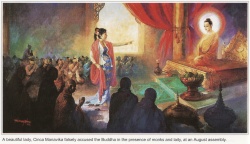Difference between revisions of "Miscellaneous Agama Sutra"
Jump to navigation
Jump to search
| Line 1: | Line 1: | ||
[[File:Ha-46.jpg|thumb|250px|]] | [[File:Ha-46.jpg|thumb|250px|]] | ||
| + | |||
| + | |||
| + | |||
| + | |||
| + | |||
| + | |||
| + | |||
| + | |||
[[Miscellaneous Agama Sutra]]<br/> | [[Miscellaneous Agama Sutra]]<br/> | ||
| + | |||
[[雑阿含経]] ([[Chin]] [[Tsa-a-han-ching]]; Jpn [[Zo-agon-gyo]] ) | [[雑阿含経]] ([[Chin]] [[Tsa-a-han-ching]]; Jpn [[Zo-agon-gyo]] ) | ||
| + | |||
One of the four {{Wiki|Chinese}} [[Agama sutras]]. It is a {{Wiki|Chinese}} translation in fifty volumes by [[Gunabhadra]] (394-468), a [[monk]] from central [[India]]. It is actually a collection of about thirteen hundred short [[sutras]] of succinct content that address [[doctrines]] on [[suffering]], [[emptiness]], [[impermanence]], and [[nonself]], as well as the [[eightfold path]]. The [[Miscellaneous Agama Sutra]] is [[thought]] to correspond to the [[Pali]] text [[Samyutta-nikaya]], a collection of about twenty-nine hundred short [[sutras]]. | One of the four {{Wiki|Chinese}} [[Agama sutras]]. It is a {{Wiki|Chinese}} translation in fifty volumes by [[Gunabhadra]] (394-468), a [[monk]] from central [[India]]. It is actually a collection of about thirteen hundred short [[sutras]] of succinct content that address [[doctrines]] on [[suffering]], [[emptiness]], [[impermanence]], and [[nonself]], as well as the [[eightfold path]]. The [[Miscellaneous Agama Sutra]] is [[thought]] to correspond to the [[Pali]] text [[Samyutta-nikaya]], a collection of about twenty-nine hundred short [[sutras]]. | ||
Latest revision as of 14:38, 1 February 2024
雑阿含経 (Chin Tsa-a-han-ching; Jpn Zo-agon-gyo )
One of the four Chinese Agama sutras. It is a Chinese translation in fifty volumes by Gunabhadra (394-468), a monk from central India. It is actually a collection of about thirteen hundred short sutras of succinct content that address doctrines on suffering, emptiness, impermanence, and nonself, as well as the eightfold path. The Miscellaneous Agama Sutra is thought to correspond to the Pali text Samyutta-nikaya, a collection of about twenty-nine hundred short sutras.
